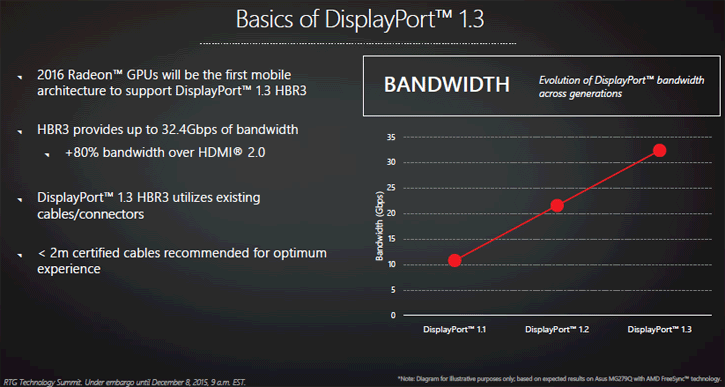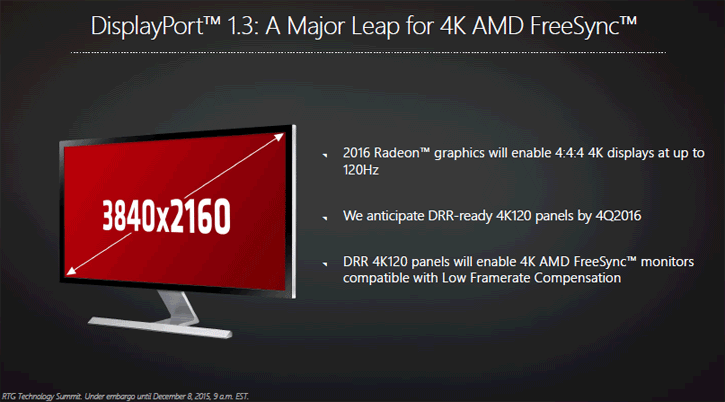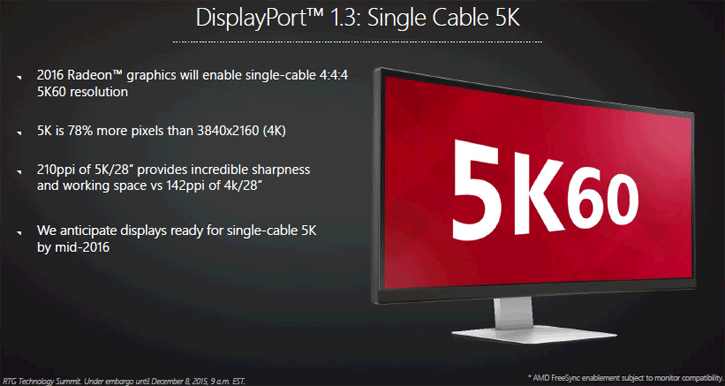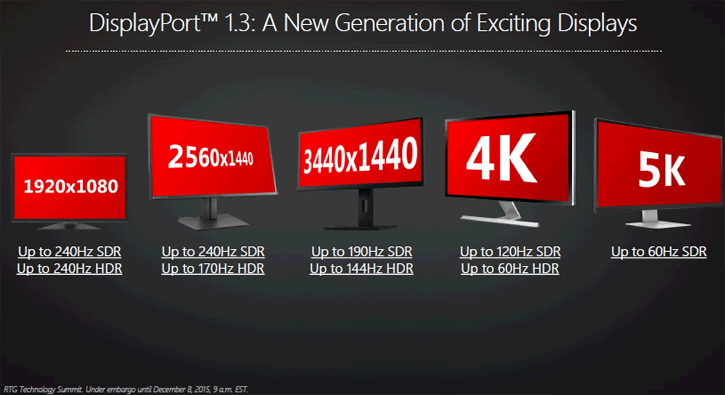Article Page 2 - High Dynamic Range Display Support and DisplayPort 1.3
High Dynamic Range (HDR) Display compatibility
AMD is going to introduce HDR for compatible displays in the need for better pixels, a wider color space, more contrast and more interesting content on that screen of yours. With Ultra HD Blu-ray to be released in February 2016 there will be a much welcomed feature, HDR. HDR will hugely increase the strength of light in terms of brightness. High-dynamic-range rendering (HDRR or HDR rendering), also known as high-dynamic-range lighting, is the rendering of computer graphics scenes by using lighting calculations done in a larger dynamic range. This allows preservation of details that may be lost due to limiting contrast ratios. Video games and computer-generated movies and special effects benefit from this as it creates more realistic scenes than with the more simplistic lighting models used. With HDR you should remember three things: bright things can be really bright, dark things can be really dark, and details can be seen in both.
High-dynamic-range will reproduce a greater dynamic range of luminosity than is possible with digital imaging. We measure this in Nits, and the number of Nits for UHD screens and monitors is going up.
What's a nit ? Candle brightness measured over one meter is 1 nits, the sun is 1.6000.000.000 nits, typical objects have 1~250 nits, current pc displays have 1 to 250 nits, and excellent hdtvs have 350 to 400 nits. A HDR OLED screen is capable of 500 nits and here it’ll get more important, new screens 2016 will go to 1000 nits. HDR offers high nits values to be used. HDR will be implemented in 2016 for PC gaming, Hollywood has already got end-to-end access content ready of course. As consumers start to demand higher-quality monitors, HDR technology is emerging to set an excitingly high bar for overall display quality. HDR panels are characterized by:
- Brightness between 600-1200 cd/m2 of luminance, with an industry goal to reach 2000
- Contrast ratios that closely mirror human visual sensitivity to contrast (SMPTE 2084)
- And the Rec.2020 color gamut that can produce over 1 billion colors at 10 bits per color
HDR can represent a greater range of luminance levels than can be achieved using more 'traditional' methods, such as many real-world scenes containing very bright, direct sunlight to extreme shade, or very faint nebulae.
HDR displays can be designed with the deeeeeeeeeeeep black depth of OLED (black is zero, the pixel is disabled), or the vivid brightness of local dimming LCD. Both are suitable for gaming. A selection of TVs are already available, and consumer monitors are expected to reach the market in the second half of 2016. Such displays will offer unrivaled color accuracy, saturation, brightness, and black depth - in short, they will come very close to simulating the real world.
Existing Radeon R9 300 Series GPUs will be compatible with HDR displays in 2016 for gaming, while our 2016 GPUs will extend support to both gaming and movies. AMD is already working with top game developers to enable HDR output from 2016 games, and will have more to share on that work next year. With the spread of TV sets with enhanced dynamic range, broadcasting HDR video may become important, but may take a long time to occur due to standardization issues.
DisplayPort 1.3
DisplayPort is a digital display interface developed by the Video Electronics Standards Association (VESA). The interface is primarily used to connect a video source to a display device such as a computer monitor, though it can also be used to carry audio, USB, and other forms of data as well actually.
The 2016 upcoming (new) AMD Radeon GPUs will offer Display port 1.3 compatibility which offers an increased overall transmission bandwidth to 32.4 Gbit/s with the new HBR3 mode featuring 8.1 Gbit/s per lane (up from 5.4 Gbit/s with HBR2 in version 1.2), totalling 25.92 Gbit/s with overhead removed.
That is over 80% the bandwidth that HDMI 2.0 offers. This enabled enables 4k gaming run on 120 Hz monitors. 4K 120Hz panels will be available in q4 2106. Low framerate compensation will be included in there as well btw.
This kind of bandwidth (32.4 Gbit/s) allows for 5K displays (5120×2880 px) in RGB mode, and 8K UHDTV displays at 7680×4320 (16:9, 33.18 megapixels) using 4:2:0 sub-sampling at 60 Hz, all using just one cable.
The bandwidth also allows for two UHD (3840×2160 px) computer monitors at 60 Hz in 24-bit RGB mode using Coordinated Video Timing, a 4K stereo 3D display, or a combination of 4K display and USB 3.0 as allowed by DockPort. The new standard features HDMI 2.0 compatibility mode with HDCP 2.2 content protection. It also supports VESA Display Stream Compression, which uses a "visually loss-less" low-latency algorithm based on predictive DPCM and YCoCg-R color space and allows increased resolutions and color depths and reduced power consumption.
That's it for this update.
H.








